Bath Electric Tramways Limited
History
By 1898, Bath Corporation had decided that any electric tramway development within the city should be under municipal control, and to this end, it successfully applied for powers to construct a standard-gauge electric tramway system. As a precursor to conversion, the corporation purchased the existing 4ft 0ins-gauge horse tramway from the Bath Road Car and Tramways Company (see link) in July 1902, the last horse tram running on the 25th of that month, which was probably the date on which the assets were handed over to the corporation.
The corporation, however, elected not to build and operate the system itself, but instead, chose to transfer its powers to Bath Electric Tramways Limited, which was formed on the 9th July 1902; work commenced on converting the system in November of that year, with the formal transfer of the corporation's tramway powers to the BETL taking place on the 3rd April 1903. Construction took over one year, the first electric services commencing on the 2nd January 1904. The system eventually totalled 14.78 miles, with lines out to Newton in the west, Weston in the north, Bathford in the east, Twerton and Oldfield Park in the south and Combe Down in the southeast.
The company appears to have always struggled financially, and somehow managed not to pay a dividend to its shareholders from 1906 through to at least the 1920s. Although there were accusations of mismanagement, independent investigation showed them to be unfounded. Bus feeder services were introduced as early as 1905, but were transferred on the 1st January 1920 to a subsidiary company — the Bath Tramway Motor Company — as a means of raising the finance necessary for tramway renewal.
In December 1936, the BETL sold out to its near neighbour, the Bristol Tramways and Carriage Company Limited (see link), which at this time, was expanding its operations, primarily through acquisition of local bus companies. As the Bath system was in need of significant investment (to renew life-expired infrastructure) it was fairly clear that its days were numbered, especially with bus replacement being high on the BT&CCL's agenda. Formal agreement — between the corporation and the company — to abandon the system, was reached on the 26th July 1937. The first abandonment took place on the 29th October 1938, with the last trams running on the 6th May 1939.
Uniforms
Tramcar crews were initially provided with double-breasted, navy-blue serge jackets, piped in red; they bore four pairs of nickel buttons (see link), and lapels. The collars bore embroidered company initials ('BETL'), certainly on the bearer's right-hand collar, and probably on the left-hand collar too given that employee numbers were carried on a metal badge worn on the jacket breast. The caps were initially soft topped with a glossy peak, though they were relatively quickly superseded by tensioned-crown peaked caps; both types bore the grade in embroidered script lettering on a hatband; 'Conductor' was definitely used, along with 'Motorman' (probably).
Early photographs show that an oval badge was worn on the left-hand breast of motormen's and conductors' jackets. The badge is believed to have been a standard numbered grade badge of the type also used by Falkirk and District Tramways (see link) and Sunderland District Electric Tramways (see link); the badges bore a number in the centre and the grade (either 'MOTORMAN' or 'CONDUCTOR'), and were probably made of nickel to match the buttons. These badges seem to have fallen out of use some time before the Great War.
At some point in the first decade of operation, but definitely prior to 1911, the style of jacket was changed to a single-breasted design with five buttons, two breast pockets (with button closures) and stand-up collars. Unfortunately, the photographic record for the 15-year period between 1911 and the mid-1920s is very poor indeed, so it is currently unclear what insignia, if any, the jackets and caps bore. A studio portrait of a Great War conductress, however, shows that a one-piece, nickel, script initials cap badge ('BETL') was being used by this time; although confirmatory photographic evidence is yet to surface, it is highly likely that this badge was used on the men's caps too.
A further change was made to the style of the uniform in the early 1930s, to a more modern cut of double-breasted jacket with four pairs buttons, and lapels. Further details are unknown.
Motormen and conductors were also provided with long, double-breasted greatcoats with five pairs of buttons, and high fold-over collars, which were usually worn open to reveal the shirt collars underneath; it is unclear whether the greatcoat collars bore embroidered badges, but surviving images would suggest not. The only badge worn was the oval grade and number badge, which was attached to the left breast. At some point the style of the greatcoats was changed to a double-breasted, lancer design with five pairs of buttons — narrowing from top to bottom — and high fold-over collars; the latter appear to have initially carried embroidered script initials, 'BETL'; these were, however, eventually superseded by the nickel script-initials badges, though possibly not until the 1930s.
Inspectors were provided with single-breasted jackets closed with hook and eye fasteners. They bore two breast pockets (with button closures) and stand-up collars, the latter carrying the company initials — 'BETL' — in embroidered script lettering. The jacket edges were finished in a fine corduroy-like material, with further embellishment provided in the form of braided epaulettes and corded flourishes around the collars. It is believed that the buttons on inspectors uniforms (pocket closures and overcoats) were brass rather than nickel. The tensioned-crown peaked caps bore the grade — 'Inspector' — embroidered in yellow script lettering on a brocade hat band.
Women were employed during the Great War — from October 1915 onwards — to replace male staff lost to the armed services, initially as conductresses , but later on as motorwomen too. These ladies wore make-shift uniforms until the official uniforms were delivered on the 1st December 1915. The new uniforms comprised single-breasted jackets with high, fold-over collars, along with matching skirts, all in navy blue serge, piped in red. Baggy motor caps were worn (with glossy peaks); these carried the standard nickel, script-initials cap badge, though they often seem to have been worn without any badge at all. Female crews were also issued with lancer-style greatcoats with high, fold-over collars, which though piped in red, bore no insignia.
Further reading
For a history of the tramway, see: 'Bath Tramways' (Locomotion Papers No 52) by Colin Magg; Oakwood Press (1971).
Images
Motormen and conductors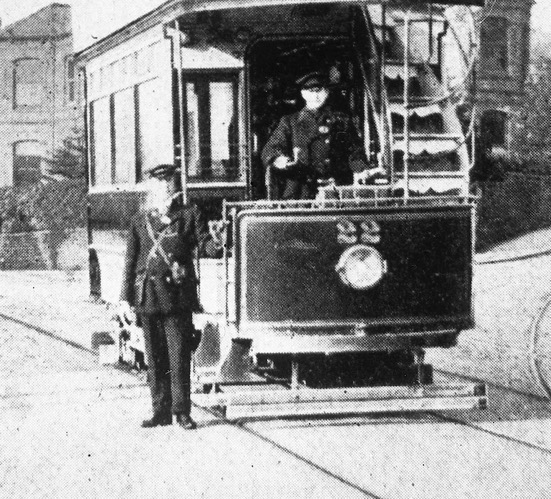
The crew of Tramcar No 22 pose for the camera at Newbridge Hill in 1904. Although of very poor quality, it does show that both motormen and conductors initially wore double-breasted jackets with lapels, and soft-topped peaked caps. Both men are also wearing an oval badge on their left-hand jacket lapels, which is believed to be of the pattern illustrated below. Photo courtesy of the National Tramway Museum. 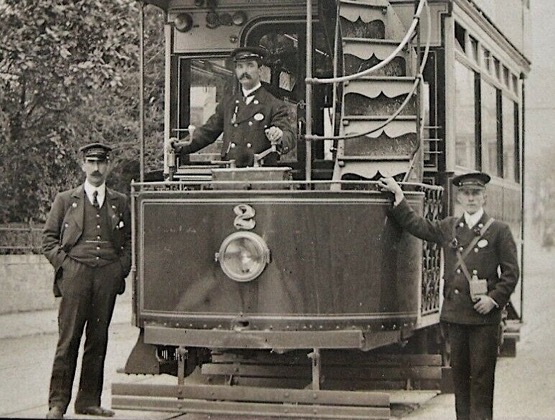
Three BETL uniformed staff pose with what would appear to be a fairly new Tramcar No 2, dating the photograph to 1904 or 1905. Both the motorman and the conductor are wearing double-breasted jackets bearing an oval badge on the breast, very probably of the pattern shown below. The man on the left may be a more senior member of staff, though this is far from clear.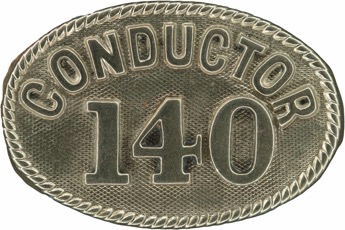
Conductor employee number badge of the type used by Bath Electric Tramways Limited from 1904 through to around the time of the Great War — nickel. Author's Collection.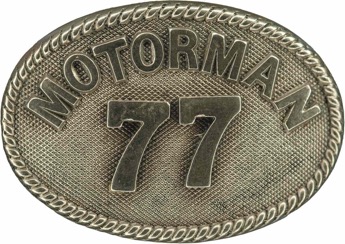
Motorman employee number badge of the type used by the Bath Electric Tramways Limited from 1904 through to around the time of the Great War — nickel. Author's Collection.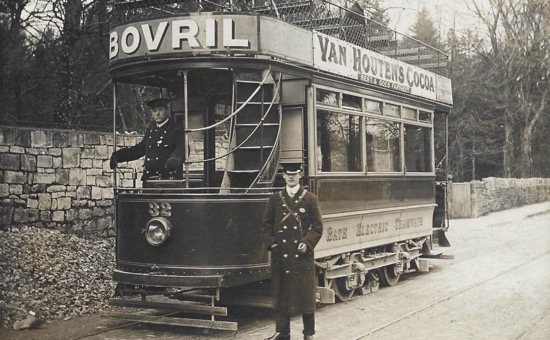
The crew of Tramcar No 32 pose for the cameraman — photo undated, but judging by the relatively good condition of the tram, probably taken in 1904 or 1905.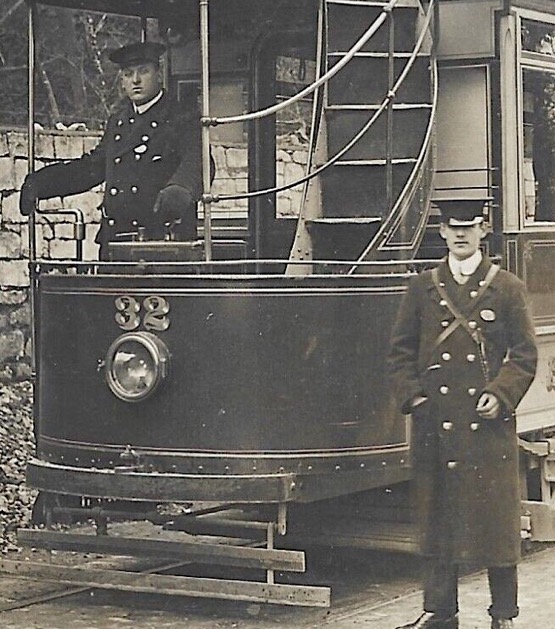
An enlargement of the above photograph showing the motorman and the conductor. Both men are wearing long, double-breasted greatcoats, as well as tensioned-crown peaked caps rather than the earlier soft-topped peaked caps. Other than the oval grade badges, the greatcoats would appear to be devoid of insignia.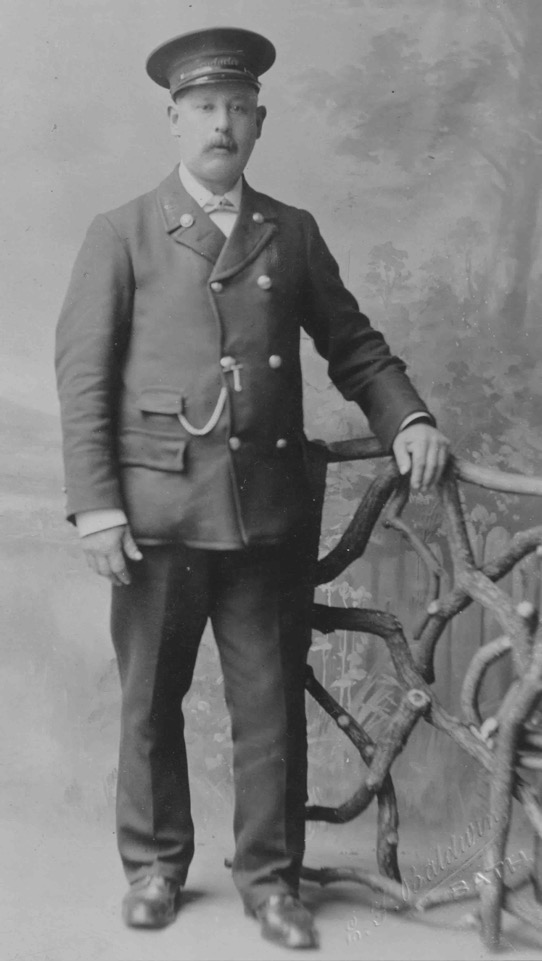
A studio portrait of a Bath Electric Tramways Limited conductor, taken in the studios of E F Baldwin of Bath – photograph undated, but probably taken in the mid-to-late Edwardian era. Author's Collection.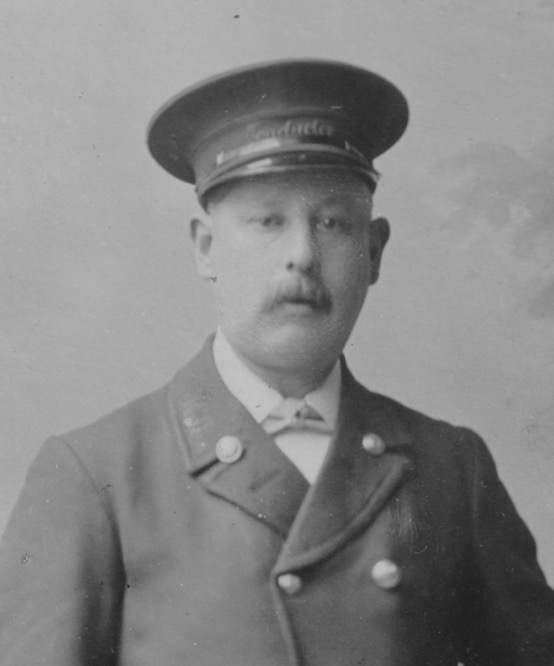
An enlargement of the above photograph showing details of the uniform and cap insignia. The subject's collars appear to bear embroidered script-lettering company initials ('BETL'), whilst the cap bears the grade ('Conductor'), again in embroidered script-lettering (on a hat band). Although the subject's jacket does not bear the usual oval grade/number badge, he may well not have taken it to the studio, especially if it was winter as it would have been on his greatcoat.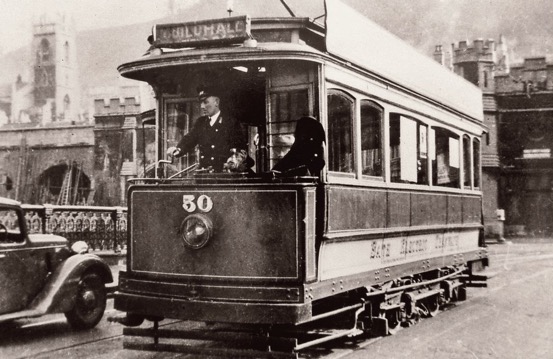
A motorman at the controls of Tramcar No 50 on Old Bridge — photo undated, but probably taken in the mid-1930s. The motorman's cap and collars clearly bear reflective badges, almost certainly the script-lettering design shown below. Source unknown.
Bath Electric Tramways cap and collar badge — nickel. This was worn from around the time of the Great War (at the latest), through to closure in 1939. Author's Collection.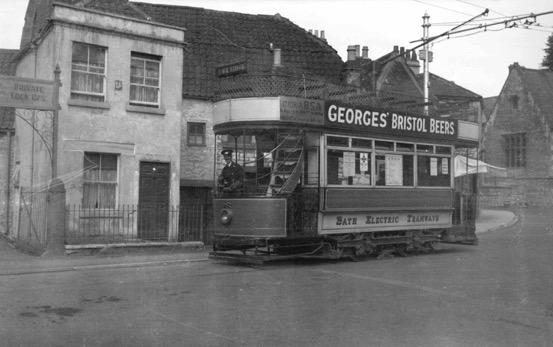
Tramcar No 12 stands at the terminus at Weston — photo undated, but probably taken in the early 1930s. Photo by Dr H Nicol, courtesy of the National Tramway Museum. 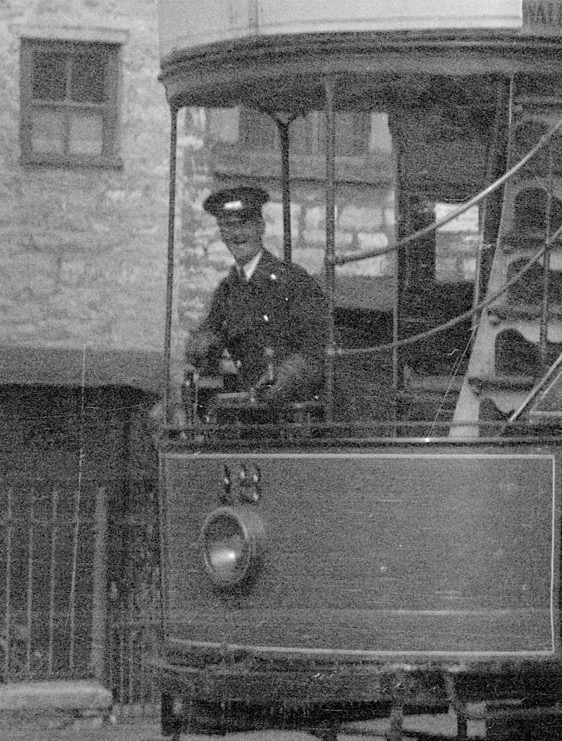
An enlargement of the above photograph showing the motorman, once again with the 'BETL' cap badge reflecting the light.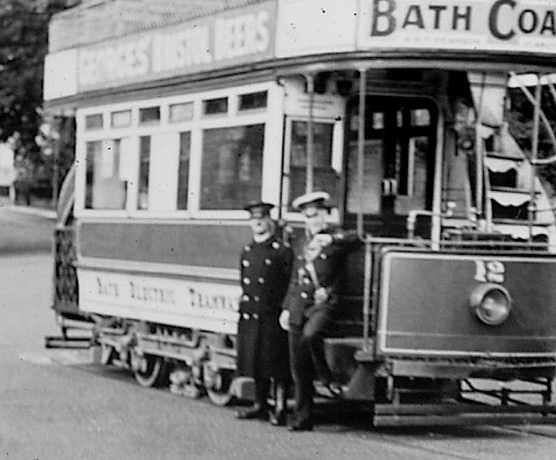
Motorman C. Lye and Conductor C. Tozer pose with Tramcar No 12 outside the Globe Inn at the Newton St Loe tram terminus — photo taken in 1935. Motorman Lye is wearing a long double-breasted, lancer-style greatcoat, whilst Conductor Tozer has the last style of uniform jacket, which was single breasted. Photo courtesy of the Tramways and Light Railway Society, with thanks to David Voice.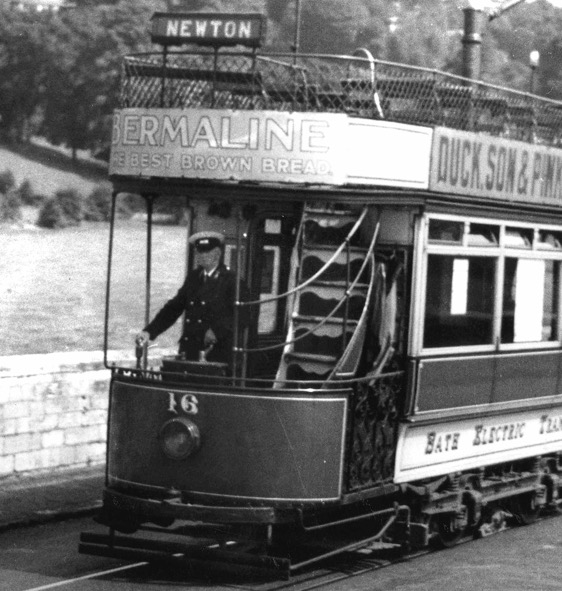
Motorman Jack Snow at the controls of Tramcar No 16 crossing the New Bridge on 18th April 1938. Photo by W A Camwell. Source unknown.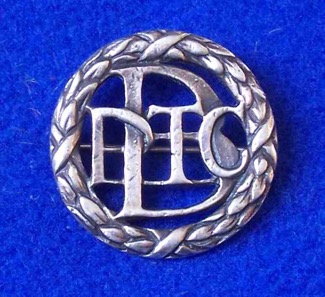
A sterling silver badge often mistakenly attributed to the BETL; it is actually from Bedford Physical Training College, now part of De Montford University.
Senior staff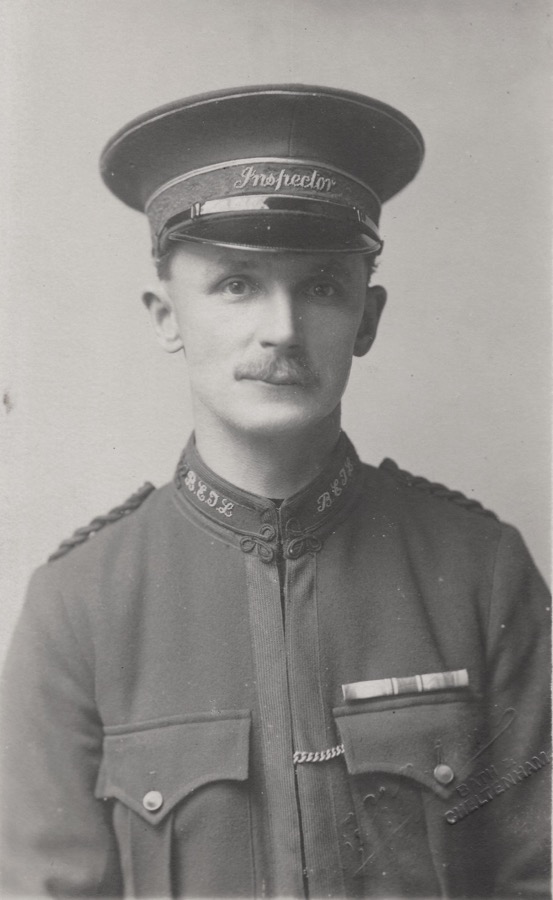
A finely executed portrait of a Bath Electric Tramways Limited inspector — photo undated, but as he is wearing a Great War medal ribbon (Star Medal; British War Medal; Victory Medal), it was probably taken in 1919 or 1920. With thanks to Sarah Wilcox, courtesy of Martyn Smyth.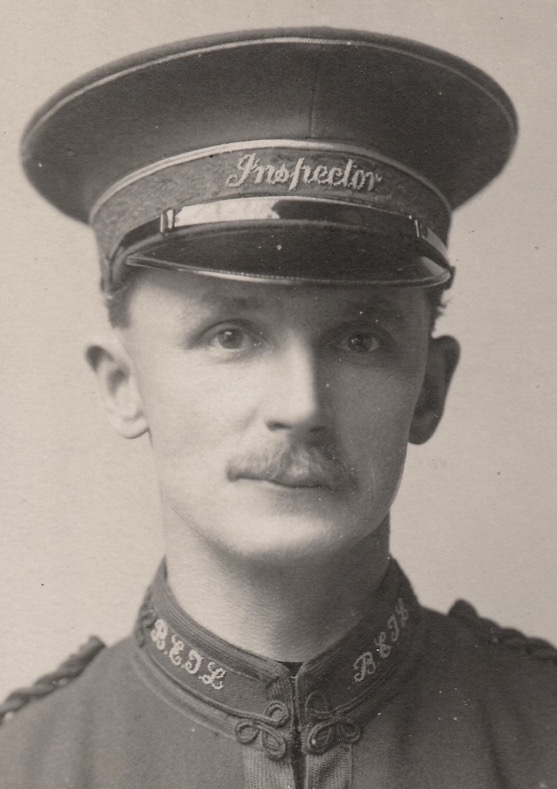
An enlargement of the above photo showing details of the insignia, as well as the intricate braid and brocade embellishments.
Female staff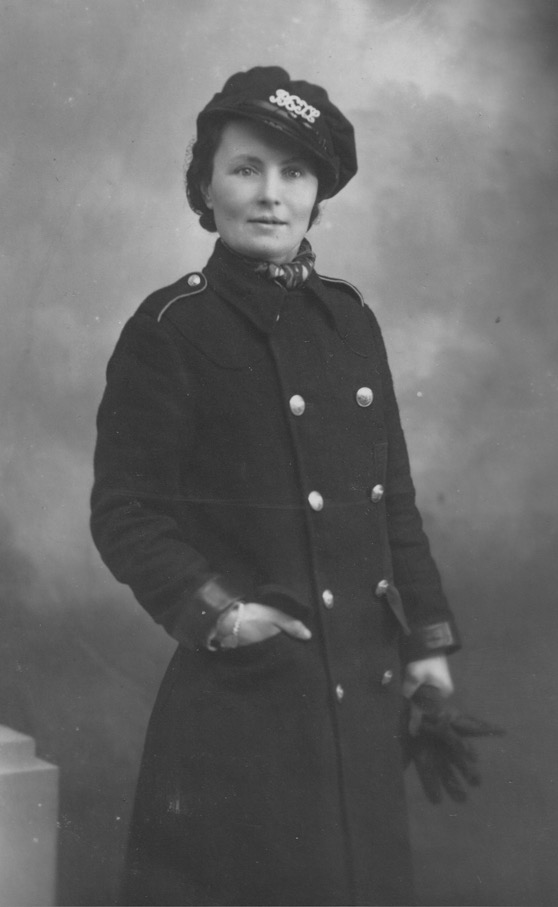
A Bath Electric Tramways Great War employee in double-breasted, lancer-style topcoat and baggy motor cap. Given that she is holding a pair of gloves, she was almost certainly a motorwoman. Author's Collection.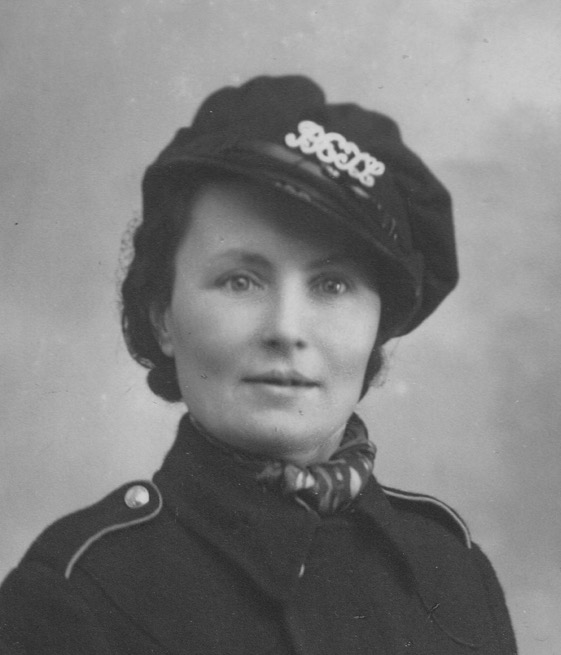
An enlargement of the above photograph showing the motor cap and the 'BETL' script-lettering cap badge.